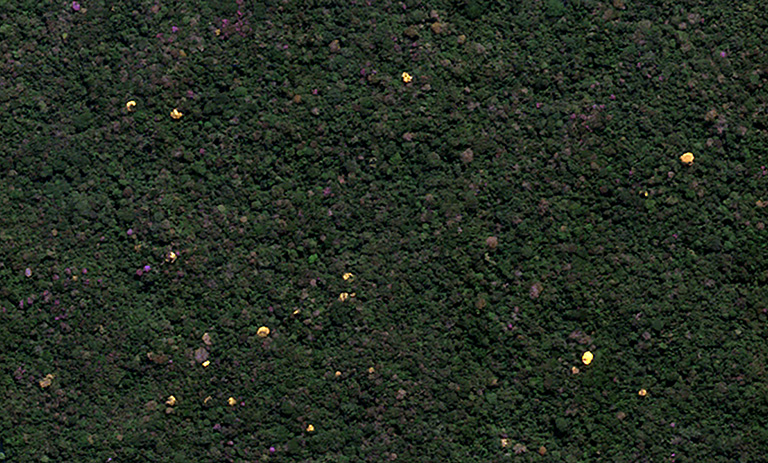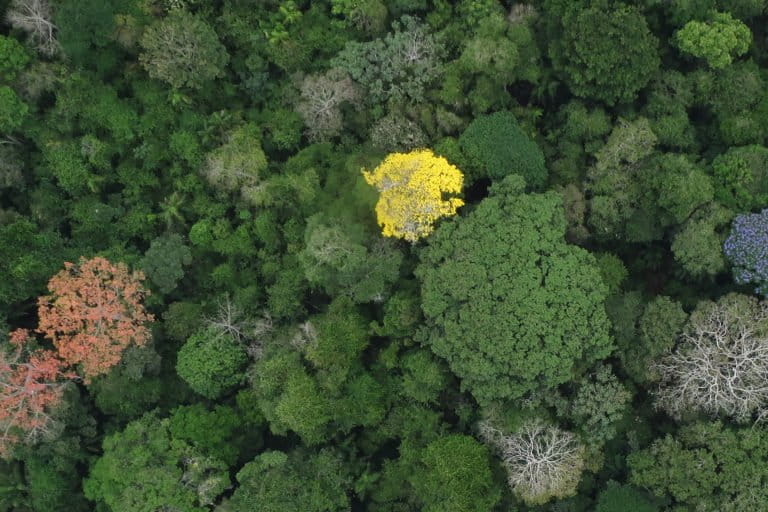- Researchers have long puzzled over why tropical forests contain such diverse species of plants and animals.
- A new study, examining the distribution of a common flowering tree in Panama, found confirmation for a decades-old hypothesis.
- This hypothesis maintains that as a species becomes more common, its natural predators limit its spread, thereby creating diversity.
- Satellite images over a 10-year period provided the evidence needed to prove the validity of this idea.
Tropical forests are incredibly diverse ecosystems, and ecologists have long wondered why.
New research studying a specific Panamanian tree – the yellow-flowering Handroanthus guayacan – has provided an answer. But the conclusion is counterintuitive. Rather than growing more abundant in areas where it is common, the tree actually increased its numbers in areas where it is rare.
Researchers at Brown University and the University of California, Los Angeles, published their findings recently in the Proceedings of the National Academy of Sciences. They used high-resolution satellite images to investigate the long-term population of this tree on Barro Colorado, a 6-square-mile [15.5-square-kilometer] island in the Panama Canal.

Using these data over a 10-year span, they confirmed a scientific hypothesis that has been around, but unproven, for decades. Developed in the early 1970s, it’s called the Janzen-Connell hypothesis after ecologists Daniel Janzen and Joseph Connell, who proposed the idea independently. It maintains that high diversity is a response to predators. Foraging efficiently, predators will hunt for their favorite foods in areas where resources are abundant, rather than in places where these resources are sparse.
“If you’re a rodent that eats seeds,” said James Kellner, an ecologist at Brown University and the first author of the study, “you’re going to go to the place where you can find a big patch of the trees or the plant that makes the seeds you want. And you can get the best bang for your buck at that location.”
As a result, seeds have the best chance to mature into adults if there aren’t other seeds around for foragers to exploit.
“It’s called a classical negative feedback,” Kellner said. “It’s a mechanism that will prevent a species from becoming common. And in the places where it’s rare, it should escape the detection of its enemies and therefore be permitted to increase in population size.”
However, testing this hypothesis has proven difficult. Examining the likelihood that a juvenile will become an adult can take decades to centuries. Compounding this is the challenge of finding species in such diverse environments.
“You need to be able to observe many square kilometers over a reasonable amount of time, and that’s not possible to do on the ground,” Kellner said.
To get around these limitations, Kellner and his colleague, ecologist Stephen Hubbell at the University of California, Los Angeles, used satellite imagery of the Handroanthus guayacan tree. For just a few days each year, adult trees of this species produce a bright yellow flower. The flower is so distinct and ubiquitous that it is easily seen – indeed, it “pops out” – in satellite imagery.
“It’s as if for a few days a year the tree is holding up a sign, and it’s telling me where it is,” Kellner said.
By studying these images, the researchers identified 1,006 adult trees on the island. Then, looking back over a 10-year period, they tracked the number and locations of adult trees. Importantly, they were able to identify when and where new trees joined the adult population. They found that these were more likely to appear in areas that contained lower densities of Handroanthus guayacan trees, just as the Janzen-Connell hypothesis predicted.

Liza Comita, an ecologist at Yale University who was not involved in the study, called the project “really novel.” “They made use of remote sensing to track adult tree recruitment over large spatial scales, which is really hard to get on the ground,” Comita said.
Kellner sees widespread and truly “game-changing” applications for remote-sensing technology when applied to ecological questions. Applying this technology will “provide new lines of evidence on old problems, and also totally new lines of evidence on problems we haven’t even identified yet,” he said.
Citation
Kellner, J.R. and Hubbell, S.P. (2018). Density-dependent adult recruitment in a low-density tropical tree. Proceedings of the National Academy of Sciences, 115 (44). 11268-11273. doi:10.1073/pnas.1800353115
Thomas Garlinghouse (@garlinghouseTom) is a graduate student in the Science Communication Program at the University of California, Santa Cruz. Other Mongabay stories produced by UCSC students can be found here.